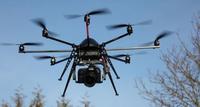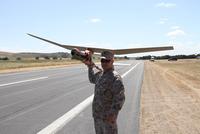-
Day of wide-spread domestic drone use nears
So far, the U.S. Federal Aviation Administration( FAA) has issued 266 active testing permits for civilian-drone applications, but has yet to allow drones wide-scale access to U.S. airspace; law enforcement and industry officials say that it is only a matter of time before the FAA would allow the more than 18,000 law enforcement agencies and departments to begin to use drones for surveillance
-
-
NASA to operate unmanned aircraft over hurricanes this year
Beginning this summer and over the next several years, NASA will be sending unmanned aircraft dubbed “severe storm sentinels” above stormy skies to help researchers and forecasters uncover information about hurricane formation and intensity changes
-
-
Can UAVs emulate bats’ flight capabilities?
The natural world has countless examples of creatures with extraordinary flight capabilities, but bats have evolved with truly extraordinary aerodynamic capabilities that enable them to fly in dense swarms, avoid obstacles, and fly with such agility that they can catch prey on the wing, maneuver through thick rainforests, and make high-speed 180 degree turns; researchers want to know whether UAVs can emulate bats
-
-
First response, law enforcement UAVs, robot markets to grow
Training and simulation account for $13.73 billion in spending by the U.S. Department of Defense budget in 2012, roughly 2 percent the DoDs total budget, and UAV training is a not-insignificant part of that budget; first-responder robot markets, valued at $440.4 million in 2011, are anticipated to reach $1.6 billion by 2018
-
-
UAV flight training and simulation market to reach $451.9 million in 2012
The proliferation of UAVs, and their utility on the modern battlefield, will see demand for the services they offer continue to rise into the next decade; this demand will be accompanied by a requirement for more skilled UAV pilots and sensor operators
-
-
FAA moves on integrating drones into U.S. airspace

The Federal Aviation Administration (FAA) now allows a government public safety agency and first responders to operate drones weighing 4.4 pounds or less in the U.S. air space, but under certain restrictions: these drones should be used for training and performance evaluation, they must be flown within the line of sight of the operator, less than 400 feet above the ground, during daylight conditions, inside Class G (uncontrolled) airspace, and more than five miles from any airport or other location with aviation activities; the FAA says that if safety agencies then apply for a waiver, the agency will allow the operation of drones weighing up to twenty-five pounds
-
-
Flying robots equipped with 3D gear: better surveillance on the cheap

Whether deployed to create virtual maps of difficult-to-access areas, monitor construction sites, measure contamination at nuclear power plants, assess conditions in a disaster-ravaged area, or identify rowdy soccer hooligans, mini UAVs could be used in a wide range of applications, obviating the need for expensive aerial photography or satellite imaging
-
-
DARPA wants technology to see through clouds
Soldiers who encounter enemy forces on the ground benefit from overhead aircraft support; some capabilities are lost, however, when cloud-cover obscures the view; DARPA is seeking advanced, flyable electronics and scene simulation technology for video synthetic aperture radar
-
-
Seattle police takes steps to quell drone concerns
The Seattle Police Department recently acquired a small camera-equipped drone, but it remains unused while city policymakers work to calm privacy concerns
-
-
U.S. military seeking non-lethal UAVs

The U.S. Army is seeking non-lethal warheads to be deployed on tiny UAVs; the U.S. Army describes the possible uses of the non-lethal UAV: “Potential commercial applications might include, but are not limited to: crowd control for local law enforcement; border protection for Homeland Security; or temporary incapacitation of non violent criminals for local SWAT teams and/or law enforcement”
-
-
First U.S. drone attack in Pakistan in a month kills four terrorists
Yesterday, Sunday, missiles launched from a CIA drone missiles hit military targets in Pakistan for the first time in a month. The attack killed four al Qaeda members, but further heightening tensions between the United States and Pakistan. Back in November 2011, U.S. airstrikes, called in by Pakistani commanders n the ground, killed twenty-four Pakistani soldiers. In response, Pakistan said that unless the United States apologized for the incident, no more U.S. drone attack would be allowed against terror targets inside Pakistan. The United States expressed regrets over the death of the soldiers, but refused to apologize, saying the accident was the result of mistakes and miscommunication on both sides. Since November, the United States has reduced considerably the number of drone attacks inside Pakistan, but has refused to end such attacks altogether. The U.S. refusal has led to Pakistani parliament, on three different occasions, to pass resolutions calling upon the United States to cease and desist.
-
-
New micro helicopters for search and rescue missions
New micro helicopters have a diameter of about fifty centimeters, weigh only 1,500 grams; they do not rquire GPS or remote control to navigate; they are designed to maneuver in tight or even enclosed spaces, and to detect and fly around any obstacle; possible uses could include protection or rescue missions, and they are ideal for flying over disaster areas and giving a picture of the situation from the air or locating victims
-
-
Worldwide UAV market to reach more than $94 billion in ten years
UAV spending will almost double over the next decade from current worldwide UAV expenditures of $5.9 billion annually to $11.3 billion, totaling just over $94 billion in the next ten years; the UAV payload market, worth $2.6 billion in Fiscal Year 2011, is forecast to increase to $5.6 billion in Fiscal Year 2020
-
-
DHS brings military technology to border surveillance
The long list of products and equipment developed for the military but which were adapted to and adopted by civilian and law enforcement agencies has a new entry. Add to the list the Kestrel: a L-3 Wescam MX 360-degree camera mounted to a Raven Aerostar aerostat
-
-
Small UAV wins Border Security Product Challenge award
A small surveillance UAV catches the eye of law enforcement and the military; it is an electric-powered, lightweight, portable system that fits in a small rucksack. Its modular design enables assembly and launch in less than two minutes
-
- All
- Regional
- Water
- Biometrics
- Borders/Immig
- Business
- Cybersecurity
- Detection
- Disasters
- Government
- Infrastructure
- International
- Public health
- Public Safety
- Communication interoperabillity
- Emergency services
- Emergency medical services
- Fire
- First response
- IEDs
- Law Enforcement
- Law Enforcement Technology
- Military technology
- Nonlethal weapons
- Nuclear weapons
- Personal protection equipment
- Police
- Notification /alert systems
- Situational awareness
- Weapons systems
- Sci-Tech
- Sector Reports
- Surveillance
- Transportation
Advertising & Marketing: advertise@newswirepubs.com
Editorial: editor@newswirepubs.com
General: info@newswirepubs.com
2010-2011 © News Wire Publications, LLC News Wire Publications, LLC
220 Old Country Road | Suite 200 | Mineola | New York | 11501
Permissions and Policies
Editorial: editor@newswirepubs.com
General: info@newswirepubs.com
2010-2011 © News Wire Publications, LLC News Wire Publications, LLC
220 Old Country Road | Suite 200 | Mineola | New York | 11501
Permissions and Policies
